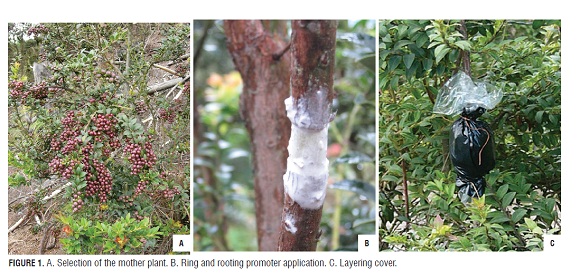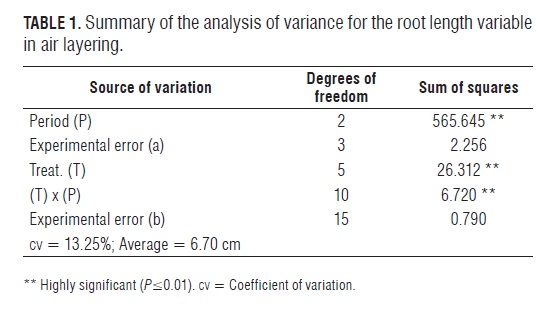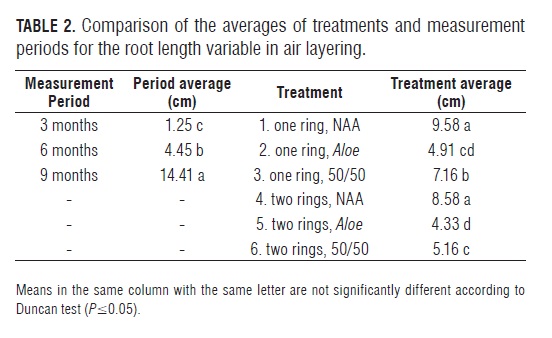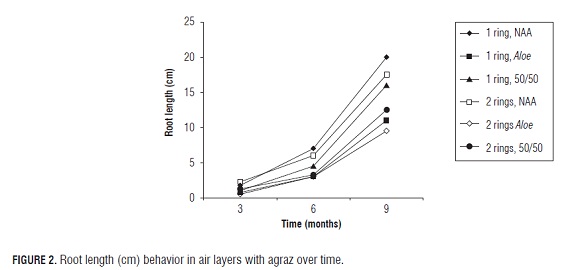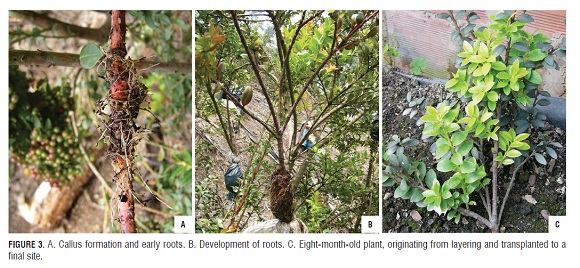Services on Demand
Journal
Article
Indicators
-
 Cited by SciELO
Cited by SciELO -
 Access statistics
Access statistics
Related links
-
 Cited by Google
Cited by Google -
 Similars in
SciELO
Similars in
SciELO -
 Similars in Google
Similars in Google
Share
Agronomía Colombiana
Print version ISSN 0120-9965
Agron. colomb. vol.31 no.2 Bogotá May/Aug. 2013
PROPAGATION & TISSUE CULTURE
Propagation of the neotropical fruit Vaccinium meridionale Swartz by air layering
Propagación del frutal neotropical Vaccinium meridionale Swartz por acodos aéreos
Gustavo Adolfo Ligarreto-Moreno1 Walter Smith Torres-Aponte1 and César Alfonso Ariza-Castillo2
1Department of Agronomy, Faculty of Agronomy, Universidad Nacional de Colombia. Bogota (Colombia). galigarretom@unal.edu.co2Faculty of Agricultural Science, Universidad de Cundinamarca. Fusagasuga (Colombia).
Received for publication: 30 April. 2013. Accepted for publication: 5 June, 2013.
ABSTRACT
Vaccinium meridionale Swartz has its natural distribution in the tropics of the New World, from 2,100 to 4,000 m a.s.l.; and is a keystone species in habitat conservation, with 3 m high shrubs when pruned. The aim of this study was to evaluate stem rooting using naphthaleneacetic acid (NAA ) and Aloe vera as rooting promoters with a farm propagation system. For this purpose, a natural population of plants was selected in San Miguel de Sema (Boyaca, Colombia), 5°31'15'' N and 73°43'39'' W, at 2,615 m a.s.l., with an average temperature of 13°C and an average annual precipitation of 1,000-1,300 mm. The results showed that the studied rooting promoters stimulated the appearance and development of roots; however, the NAA treatments had greater root growth over time. Developing air layers allowed for their separation from the mother plants and transplant 6 months after the application of the rooting promoters started.
Key words: agraz, mortiño, Neotropical Ericaceae, rooting.
RESUMEN
El agraz (Vaccinium meridionale Swartz), tiene su distribución natural en el tropico del nuevo mundo, desde 2.100 hasta 4.000 m de altitud, es una especie fundamental en la conservación del hábitat; son arbustos que manejados con podas se pueden mantener en una altura no mayor de 3 m para facilitar su manejo. En el estudio se evaluó el potencial de enraizamiento de las ramas de agraz utilizando el ácido naftalenacético (ANA ) y el Aloe vera como promotores de enraizamiento, bajo el sistema de propagación en la finca. Para el efecto, se seleccionó una población natural ubicada en el municipio de San Miguel de Sema (Boyacá, Colombia), a 5°31'15'' N, 73°43'39'' O, a 2.615 msnm, con una temperatura promedio de 13°C y una precipitación promedio anual de 1.000-1.300 mm. De los tratamientos aplicados se encontró que los dos promotores de enraizamiento utilizados estimularon la aparición y desarrollo de las raíces, no obstante los tratamientos con ANA presentaron mayor crecimiento de las raíces a través del tiempo. El desarrollo radical permitió separar los acodos de la planta madre y llevarlos al sitio de trasplante después de transcurrir 6 meses desde el momento de aplicar los promotores de enraizamiento.
Palabras clave: agraz, mortiño, ericáceas del neotropico, enraizamiento.
Introduction
The genus Vaccinium is part of the Ericaceae family, which contains ornamental and edible genera, among the edibles ones are North American cranberries, North American blueberries, European blueberries or bilberries and berries of the Neotropics; and is the largest genus of the tribe Vaccinieae (Lens et al., 2004; Dastmalchi et al., 2011; Luteyn, 2002).
Vaccinium meridionale Swartz, known as "agraz", is found in Venezuela, Colombia, Ecuador, Peru and Jamaica, is located in the Andean paramos, is a keystone species in the conservation of the high Andean habitat, especially for soil remediation, and is threatened by deforestation and improper practices during harvesting of fruits (Echeverri, 2003). They are shrubs up to 8 m high, or 2-3 m pruned, but fruiting can be seen in plants of less than a meter. The fruit is a spherical, false berry, 0.3 to 1.8 cm in diameter; its color is purple when ripe, and it has a sweet and sour taste and high contents of protein, fiber, vitamins A, B1, B2, B6 and C and elements such as sodium, potassium, calcium, magnesium, manganese, iron, copper, phosphorus and chlorine, anthocyanins and phenols, and so, is considered a nutraceutical food (Ávila et al., 2007; Gaviria et al., 2009).
In Colombia, with studies on the propagation of the species with the participation of farmers from the cooler climates of the departments Cundinamarca and Boyacá, it was possible to make a first approximation of the scaling of seedlings, combining fruit multiplication techniques with seeds (Magnitskiy and Ligarreto, 2009; Castro et al., 2012) and by different methods of vegetative propagation: cuttings (Castrillón, 2008; Ávila Díaz-Granados et al., 2009) buds and air layers (Ligarreto, 2011) and in vitro propagation from cotyledonary and hypocotyls leaves (Ariza et al., 2010) and apex shoots (Rache and Pacheco, 2010).
Studies have investigated the propagation of V. meridionale by seed, which results in slow growth of seedlings (Magnitskiy and Ligarreto, 2007), and being a cross-pollination species, the plants may present high genetic variability. Propagation by cuttings is faster than the seed method but rooting is very unpredictable, which is inconvenient when using the material for the establishment of commercial orchards, leading to the need to develop protocols that generate rapid growth through asexual propagation of the species, thereby saving time and ensuring easy and rapid crop establishment (Ligarreto, 2011).
Paul and Aditi (2009) argued that the principal constraints of low productivity of some fruits are the unavailability of planting materials of superior cultivars and poor management of orchards. For many wild plants, studies have been conducted on methods of propagation by rooting cuttings with unsatisfactory results, mainly due to genetic variability in these populations, making it difficult to standardize these protocols.
Other reasons for difficulty in propagating these species were established by Trevisan et al. (2008), who mentioned various factors, both endogenous and exogenous, that affect the rooting capacity, among which are the type of substrate, growth regulators, environmental factors, plant age, physiological condition of the mother plant, type of cutting, time of cutting and the action of oxidizing agents specific to each plant.
Taking into account the above mentioned factors and variability in wild species, methods of propagation have been established under in situ conditions, of which one of the most common is the layering system (Trevisan et al., 2008). The success of layering depends on several factors, notably: the plant species, stage of development of the plant, location in the branch where rooting will be induced, carbon/ nitrogen ratio (C/N) and environmental factors dependent on the time of execution, as well as the substrate used (Barbosa et al., 1993).
Various classes of growth regulators, such as auxins, cytokinins, gibberellins, ethylene, and inhibitors such as abscisic acid influence root initiation. Of these, promoting substances such as IBA and NAA help achieve rooting in a short time during layering (Bose et al., 1997). Other authors such as Dagne et al. (2000) have reported that vegetable extracts of the genus Aloe are a source of about 75 biologically active components including different kinds of vitamins, minerals, sugars, lignins, saponins, salicylic acid and amino acids that promote cellular conservation and multiplication; Surjushe et al. (2008) reported that Aloe also contains hormones that are between auxins and gibberellins, which promote root growth in plants.
The present study evaluated the rooting potential of V. meridionale branches using rooting promoters in order to establish a recommendation that is easy, low-cost and efficient for the production of clonal material and subsequent establishment of plants in a productive culture system, using, as a starting point, the selection of elite plants for the production and the quality of the fruit.
Materials and methods
Population location
This study used a natural population of V. meridionale, representative of the neotropics, located on the San Antonio farm, in the Centro rural lane and municipality of San Miguel de Sema, (Colombia), in the western province of the Boyaca department, 5°31'15'' N, 73°43'39'' W, at an altitude of 2,615 m, with an average temperature of 13°C and an average annual rainfall of 1,000-1,300 mm with bimodal rainfall, concentrated in the months of April to May and October to November. The landscape contains moderate slopes and characteristics specific to the agroecological environments of the species, as reported by Muñoz et al. (2009).
Experimental design
For evaluating the response of the rooting V. meridionale branches, a completely randomized block design was utilized with a 2 x 3 factorial arrangement, the first factor (A) was the ring system in the branches to be rooted, with levels: one and two rings, the second factor (B) corresponded to the rooting agent, with three levels: (1) naphthaleneacetic acid (NAA ) (0,4%, commercial Hormonagro 1®; Colinagro, Bogota), (2) Aloe extract (Aloe vera) and (3) Aloe mix with NAA , at equal proportions for the weight ratio (50/50); the experimental unit was three-layers per treatment with two shrubs. The response to treatment was quantified at 3, 6 and 9 months.
Variable response
The response to the applied treatments was assessed as the length of the roots with air layering over time.
Biometric analysis
Analysis of variance was combined by periods and variance for the factorial arrangement, besides with comparison tests for the averages with 5% significance. The data were processed with the software: SAS ®, v. 9.4.
Layering
The method consisted of choosing plants with desired yield and fruit size characteristics (Fig.1A), subsequently, one or more good sized branches were selected within the canopy with diameters of approximately 1.2 cm. The rings were made at a distance of 30 to 40 cm from the distal portion of the stem, toward the bottom, removing 2.0 to 2.5 cm from the bark of the branches with two parallel cuts (Fig.1B). The ring was impregnated with rooting promoters and covered with loose, moist substrate consisting of a mixture of moss and soil obtained from the same place as the mother plant, and in turn, was wrapped with transparent plastic and black plastic on the exterior to prevent exposure to sunlight (Fig.1C). The plastic cover was tied at the ends to prevent moisture loss and promote the emission of roots. For treatments with two rings, the same technique was used, leaving 1 cm between the rings (Ligarreto, 2011).
Results and discussion
In the quantification of V. meridionale root development in the air layers, highly significant statistical differences were detected for the three periods of the evaluation, the treatments and the treatments x measurement periods interaction (Tab.1). For the periods, at 3 months, the state of development of the layering included a tissue thickening event in the form of callus in the region of the rings, which is where root emission initiated, which on average, reached a length of 1.25 cm, differing significantly with the readings of 6 and 9 months, where root lengths obtained 4.45 and 14.41 cm, respectively, which also differed statistically from each other (Tab.2).
V. meridionale is a species with a natural population in the Colombian Andean highlands and has spread by seeds and clonal growth strategies, which, for the former, has gained low genetic diversity, however, a growing number of studies have found that clonal plant populations can have high genetic diversity (Widén et al., 1994). With the results of this study, an important factor for consideration in the proposed layering method of V. meridionale is maintaining genetic variation by propagating plants from populations with high initial genetic diversity, sustained over time by vegetative growth (Raspé and Jacquemart, 2003).
In the development of the root system with layering, the organic matter is a key component in the substrate; the mixture of moss and topsoil used in this study provided for this, which facilitated the successful engraftment of the layerings; according to Cordell and Filer (1984), the substrate should increase the capacity of water and nutrient retention for the developing seedlings. With respect to pH, the substrate must have values within what is considered appropriate for plant growth, which for Vaccinium is between 4.0 to 5.5; inadequate values influence the availability of nutrients and are related to physiological imbalances (Ristow et al., 2011).
Therefore, for layering, a mixture of the forest litter and the soil of the forest where the mother plants are found is recommended as the substrate, as this soil retains both the physical and chemical conditions to which the plants from the natural populations are adapted.
Table 2 demonstrates the rapid growth in root length after 6 months, which is accompanied by a slight foliar stress found in the leaves of the rooted branch with slight turgor, possibly due to the translocation of photosynthates to new root tissue. One can see that at 7 months, the layerings had a new clonal explant that is suitable for separation from the mother plant and beginning the nursery stage, given that, since root growth is rapid and abundant at this time, good crop establishment is possible (Fig.2 and 3A, B).
In the root behavior with layering response to the application of ring treatments and rooting promoters, the highest averages were achieved with one ring with no statistical difference with two rings, with applications of NAA and Aloe; in the first case, with NAA , the averages for root length were 9.58 cm with one ring and 8.58 cm with two rings, as opposed to Aloe, with the root length only reaching 4.91 cm with one ring and 4.33 cm with two rings. In the case of the 50/50 mixture (NAA + Aloe), the behavior was intermediate with respect to the other treatments but contrasting in magnitude, 7.16 cm with one ring and 5.16 cm with two rings, with no statistical difference between them (Tab.2).
The statistical significance of the treatment x time period interaction in the average length of the roots with layers is explained in Fig.2 by the cross effect of NAA with one and two rings between the periods of 3 and 6 months, similarly, but with lower values, the same effect was seen for Aloe between the same periods. On the other hand, the behavior between the periods of 6 and 9 months did not see crossings occur in the trends of any of the treatments, which presented upward growth, as shows the analysis of the factors number of rings and rooting regulators at the 9 month period.
Table 3, when analyzing the factorial arrangement, demonstrates the statistically significant differences that were found in factor A: one and two rings; and the highly significant differences that were found in the rooting promoters (factor B), with no statistical A x B interaction (Tab.3). Tab.4 shows that the average root length with the one ring system was 15.67 cm, while with two rings, it was 13.16 cm; this difference can be explained by the physiological competition of the branch, having to form bigger callus areas when there are two rings and hence displaying slower rooting and development processes as compared with the treatments with one ring (Tab.4).
Tab.4 shows the large statistical difference between the rooting promoters; the NAA treatments presented more root growth with an average length of 18.75 cm, followed by NAA + Aloe, with an average of 14.25 cm and Aloe with the shortest root length of 10.25 cm, all averages displayed statistical differences; in addition, the layers treated with NAA had the highest development of root hairs, reaching lengths of 2 cm, these results contrast with those reported by Rodríguez (2006) for the stimulating growth effects from an extract gel of A. vera in the cultivation of medicinal plants, particularly in relation to the formation of roots surpassing the synthetic regulators used.
In promoting V. meridionale roots, the moss and soil substrate was an important factor which facilitated their growth and; and, as is common for the Vaccinium genus, a very superficial root system, very thin roots and a lack of root hairs were seen (Shelton and Moore, 1981). The substrate avoided compacting the root mass and provided the acidic condition necessary for growth, similar to different reports that have suggested that Vaccinium has no apparent problems with root development in soils with a pH close to 5.0, since they are rich in organic matter (Hanson and Hancock, 2003).
The above results indicate that after 3 months of applying rooting promoters to V. meridionale branches, growth of the root system was rapid, which was even more noticeable at 6 months, indicating that this phase of air layering was successful and that it is the appropriate time to make a cut from the branch for the nursery stage, where it is planted in 1 or 2 kg bags with an organic and loose substrate; the nursery period can last from 3-4 months; at this stage, conditions of low sun exposure should be maintained, along with constant humidity and a temperature of 16-18°C for the new plant to begin nutrient uptake, and promote growth, the emergence of new roots and anchoring in the substrate; conditions that facilitate survival, which is reflected by the presence of new foliar shoots, demonstrating the adaptation of the new plant to separation from the mother plant, and only at this time, can one carry out transplantation to the final site (Fig.3).
Lopes et al. (2005) commented that the layering system represents the most successful vegetative propagation for some tropical fruit species in the wild, such as the cashew apple (Anacardium occidentale); and is a process for rapid multiplication of plants, which fully reproduces the genetic characteristics of the plants but presents a high death rate, mainly after transplanting the seedlings. The same is true for Vaccinium, the most critical stage and the one which can present an increased plant mortality rate is the transplantation stage, either in the nursery bag or the final site, so caution should be exercised with the technique used for this purpose. It is essential, before starting the scaling system in the vegetative propagation of V. meridionale, to consider the clonal structure of the species, since in large clonal populations, a higher proportion of self-pollination is expected and hence less genetic variation than small populations, which in turn, can be more easily surrounded by clones of different genotypes and result in more significant genetic variants in the establishment of crops (Handel, 1983; Raspé and Jacquemart, 2003).
Conclusions
We propose a new clonal propagation system for V. meridionale plants, rooting branches of elite plants or air-layering on farms or in natural populations of Colombian Andean forests; the technique is efficient because one can obtain several daughter clonal plants from the same plant without altering the development of the mother plant, it is low cost and, due to its ease of use, can be done directly by farmers. The rooting promoters Hormonagro 1® (NAA ) and Aloe (Aloe vera) presented positive results for their use as root growth regulators in V. meridionale, due to their efficiency and low cost.
The asexual propagation technique "air layering", as applied to V. meridionale, resulted in a system for providing good-sized seeding material, reaching heights of up to 40 cm at 8 months of age, while with the other reported techniques, this height is reached at two years of age of the plant. In addition, it improves the possibility of establishing a high-yield culture with phenotypic homogeneity and genetic variability.
Acknowledgements
The authors wish to thank Carlos Moreno, a farmer of the municipality of San Miguel de Sema, Boyaca, for providing its plantation of V. meridionale for this propagation study and S. Magnitskiy for reviewing the text. This research was funded by the Ministerio de Agricultura y Desarrollo Rural and the Universidad Nacional de Colombia, Bogota.
Literature cited
Ariza, C., G. Ligarreto, and T. Mosquera. 2010. Multiplicación in vitro de agraz (Vaccinium meridionale Swartz) a través de inducción de organogénesis directa. p. 44. In: Memorias del Congreso Iberoamericano de Horticultura, Innovación Tecnológica y Mercados Competitivos 2010-2020. Universidad Militar Nueva Granada, Bogota. [ Links ]
Ávila, H., J. Cuspoca, G. Fischer, G.A. Ligarreto, and M. Quicazán. 2007. Caracterización fisicoquímica y organoléptica del fruto de agraz (Vaccinium meridionale Sw.) almacenado 1 a 2°C. Rev. Fac. Nac. Agron. Medellin 60(2), 4179-4193. [ Links ]
Ávila Díaz-Granados, R.A., O.J. Orozco, G. Ligarreto, S. Magnitskiy, and A. Rodríguez. 2009. Influence of mycorrhizal fungi on the rooting of stem and stolon cuttings of the Colombian blueberry (Vaccinium meridionale Swartz). Inter. J. Fruit Sci. 9, 372-384. [ Links ]
Barbosa, K.M., F.C. Guedes, F.A. Guedes, P.S. Lima, and J.J. Lima. 1993. Efeito do substrato no enraizamento de alporques do Uruzeiro. Pesq. Agropec. Bras. 28(1), 101-106. [ Links ]
Bose, T.K., S.K. Mitra, M.K. Sadhu, and P. Das. 1997. Propagation of tropical and subtropical horticultural crops. Cornell University, Cacutta, India. [ Links ]
Castrillón, J.C., E. Carvajal, G.A. Ligarreto, and S. Magnitskiy. 2008. El efecto de auxinas sobre el enraizamiento de las estacas de agraz (Vaccinium meridionale Swartz) en diferentes sustratos. Agron. Colomb. 26(1), 16-22. [ Links ]
Castro, C., Y. Olarte, L. Rache, and J. Pacheco. 2012. Development of a germination protocol for blueberry seeds (Vaccinium meridionale Swartz). Agron. Colomb. 30(2), 196-203. [ Links ]
Cordell, C.E. and T.H. Filer. 1984. Integrated nursery pest management. pp. 1-17. In: Landz, C.W. (ed.). Southern pine nursery handbook. Forest Service, US DA, Atlanta, GA . [ Links ]
Dagne, E., D. Bisrat, A. Viljoen, and B.E. Van Wyk. 2000. Chemistry of Aloe species. Curr. Org. Chem. 4, 1055-1078. [ Links ]
Dastmalchi, K., G. Flores, V. Petrova, P. Pedraza-Peñalosa, and E. Kennelly. 2011. Edible neotropical blueberries: Antioxidant and compositional fingerprint analysis. J. Agric. Food Chem. 59, 3020-3026. [ Links ]
Echeverri, A. 2003. Conozcamos y usemos el mortiño. Corporación Autónoma Regional del Centro de Antioquia (Corantioquia), Medellin, Colombia. [ Links ]
Gaviria, C.A., C.I. Ochoa, N.Y. Sánchez, C.I. medina, M. Lobo, P.L. Galeano, A.J. Mosquera, A. Tamayo, Y.E. Lopera, and B.R. Rojano. 2009. Propiedades antioxidantes de los frutos de agraz o mortiño (Vaccinium meridionale Swartz). pp. 93-112. In: Ligarreto, G. (ed.). Perspectivas del cultivo del agraz o mortiño (Vaccinium meridionale Swartz) en la zona altoandina de Colombia. Universidad Nacional de Colombia, Bogota. [ Links ]
Handel, S.N. 1983. Pollination ecology, plant population structure, and gene flow ages. pp. 163-211. In: Real, L. (ed.). Pollination biology. Academic Press, Orlando, FL. [ Links ]
Hanson, E. and J. Hancock. 2003. Managing the nutrition of highbush blueberries. In: Memorias Jornada de arándanos - producción en Argentina. Fauba, Buenos Aires. [ Links ]
Lens, F., K.A. Kron, J. Luteyn, E. Smets, and S. Jansen. 2004. Comparative wood anatomy of the blueberry tribe (Vaccinieae, Ericaceaes L.) Ann. Mo. Bot. Gard. 91, 566-592. [ Links ]
Ligarreto, G.A. 2011. Agraz (Vaccinium meridionale Swartz): algunas prácticas de cultivo y poscosecha. Universidad Nacional de Colombia, Bogota. [ Links ]
Lopes R.L., I.H. Lucena, I.V. De Morais, and A.B. Geraldo. 2005. Indol-butyric acid levels on cashew cloning by airlayering process. Rev. Bras. Frutic. 27(3), 517-518. [ Links ]
Luteyn, J. 2002. Diversity, adaptation, and endemism in neotropical Ericaceae: Biogeographical patterns in the Vaccinieae. 68(1), 55-87. [ Links ]
Magnitskiy, S.V. and G.A. Ligarreto. 2007. El efecto del nitrato de potasio, del ácido giberélico y del ácido indolacético sobre la germinación de semillas de agraz (Vaccinium meridionale Swartz). Rev. Colomb. Cienc. Hort. 1(2), 137-141. [ Links ]
Magnitskiy, S.V. and G.A. Ligarreto. 2009. Plantas de agraz o mortiño (Vaccinium meridionale Swartz): potencial de propagación sexual. pp. 75-91. In: Ligarreto, G. (ed.). Perspectivas del cultivo de agraz o mortiño (Vaccinium meridionale Swartz) en la zona altoandina de Colombia. Universidad Nacional de Colombia, Bogota. [ Links ]
Muñoz, J.D., L.J. Martínez, and G.A. Ligarreto. 2009. Caracterización de los ambientes agroecológicos del agraz o mortiño (Vaccinium meridionale Swartz), en la zona altoandina de Colombia. pp. 29-56. In: Ligarreto, G. (ed.). Perspectivas del cultivo de agraz o mortiño (Vaccinium meridionale Swartz) en la zona altoandina de Colombia. Universidad Nacional de Colombia, Bogota. [ Links ]
Paul, R. and Ch. Aditi. 2009. IBA and NAA of 1000 ppm induce more improved rooting characters in air-layers of waterapple (Syzygium javanica L.). Bulg. J. Agric. Sci. 15, 123-128. [ Links ]
Rache, L.Y. and J.C. Pacheco. 2010. Propagación in vitro de plantas adultas de Vaccinium meridionale (Ericaceae). Acta Bot. Bras. 24(4), 1086-1095. [ Links ]
Raspé, A.T. and A.l. Jacquemart. 2003. Clonal structure in Vaccinium myrtillus L. revealed by RAPD and AFLP markers. Inter. J. Plant Sci. 164, 649-655. [ Links ]
Ristow, N.C., L.E. Correa, S. Carpenedo, and M. Wulff Schuch. 2011. Diferentes substratos naprodução de mudas de Mirtileiro. Cienc. Rural 41(7), 1154-1159. [ Links ]
Rodríguez, H. 2006. Gel de Aloe vera y harina de según como soporte sólido de medios de cultivo para plantas medicinales. Rev. Cubana Plant. Med. 11(1). [ Links ]
Shelton, L.L. and J.N. Moore. 1981. Highbush blueberry propagation under southern U.S. climatic conditions. HortScience 168(3), 320-321. [ Links ]
Surjushe, A., R. Vasani, and D. Saple. 2008. Aloe vera: A short review. Ind. J. Dermatol. 53(4), 163-166. [ Links ]
Trevisan, R., R.C. Franzon, R.F. Neto, R. Gonçalves, E. Dias, and L.E. Corrêa. 2008. Enraizamento de estacas herbáceas de mirtilo: influência da lesão na base e do ácido indolbutírico. Ciênc. Agrotec. 32(29), 402-406. [ Links ]
Widén, B., N. Cronberg, and M. Widén. 1994. Genotypic diversity, molecular markers and spatial distribution of genets in clonal plants, a literature survey. Folia Geobot. Phytotaxon. 29, 245-263. [ Links ]













